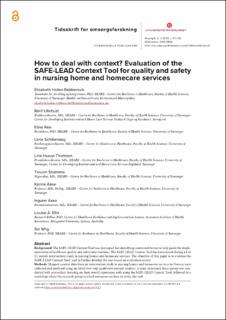| dc.contributor.author | Holen-Rabbersvik, Elisabeth | |
| dc.contributor.author | Ullebust, Berit | |
| dc.contributor.author | Ree, Eline | |
| dc.contributor.author | Schibevaag, Lene | |
| dc.contributor.author | Hurup-Thomsen, Line | |
| dc.contributor.author | Strømme, Torunn | |
| dc.contributor.author | Aase, Karina | |
| dc.contributor.author | Aase, Ingunn | |
| dc.contributor.author | Ellis, Louise | |
| dc.contributor.author | Wiig, Siri | |
| dc.date.accessioned | 2023-01-09T13:34:43Z | |
| dc.date.available | 2023-01-09T13:34:43Z | |
| dc.date.created | 2020-11-21T10:11:02Z | |
| dc.date.issued | 2020 | |
| dc.identifier.citation | Holen-Rabbersvik, E., Ullebust, B., Ree, E., Schibevaag, L., Hurup-Thomsen, L., Strømme, T., ... & Wiig, S. (2020). How to deal with context? Evaluation of the SAFE-LEAD context tool for quality and safety in nursing home and homecare services. Tidsskrift for omsorgsforskning, 6(2), 87-102. | en_US |
| dc.identifier.issn | 2387-5976 | |
| dc.identifier.uri | https://hdl.handle.net/11250/3042020 | |
| dc.description.abstract | Background: The SAFE-LEAD Context Tool was developed for identifying contextual factors to help guide the implementation of healthcare quality and safety interventions. The SAFE-LEAD Context Tool has been tested during a 6 to 12-month intervention study in nursing homes and homecare services. The objective of this paper is to evaluate the SAFE-LEAD Context Tool, and to further develop the tool based on evaluation results.
Methods: Mapped context data from an intervention study in nursing homes and homecare services in Norway were collected and analysed using an initial two-step qualitative content analysis. A semi-structured focus group was conducted with researchers focusing on their overall experience with using the SAFE-LEAD Context Tool, followed by a workshop where the research group reached consensus on how to revise the tool.
Results: Major changes were made to the introductory and final sections of the tool to allow process documentation based on predefined categories. Minor revisions were also made, relating mainly to the consolidation and clarification of terms to better reflect our intended meaning.
Conclusion: The revised SAFE-LEAD Context 2.0 is a theoretically based, and empirically tested tool adapted for context mapping in quality and safety research interventions in nursing home and homecare services. | en_US |
| dc.language.iso | eng | en_US |
| dc.publisher | Universitetsforlaget | en_US |
| dc.rights | Navngivelse 4.0 Internasjonal | * |
| dc.rights.uri | http://creativecommons.org/licenses/by/4.0/deed.no | * |
| dc.title | How to deal with context? Evaluation of the SAFE-LEAD Context Tool for quality and safety in nursing home and homecare services | en_US |
| dc.type | Peer reviewed | en_US |
| dc.type | Journal article | en_US |
| dc.description.version | publishedVersion | en_US |
| dc.rights.holder | the authors | en_US |
| dc.subject.nsi | VDP::Medisinske Fag: 700 | en_US |
| dc.source.pagenumber | 87-102 | en_US |
| dc.source.volume | 6 | en_US |
| dc.source.journal | Tidsskrift for omsorgsforskning | en_US |
| dc.source.issue | 2 | en_US |
| dc.identifier.doi | 10.18261/issn.2387-5984-2020-02-07 | |
| dc.identifier.cristin | 1850613 | |
| dc.relation.project | Norges forskningsråd: 256681 | en_US |
| dc.relation.project | Universitetet i Stavanger: 5091 | en_US |
| cristin.ispublished | true | |
| cristin.fulltext | original | |
| cristin.qualitycode | 1 | |

